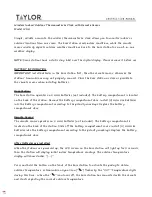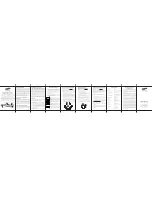
32
11
DATA ACQUISITION OPERATIVE MODE
When the optional accessory of the instrument is specified (Internal data RS232 a LogMan software)
the instrument is equipped with an internal memory to store up to 500 input data records. Two types of data acquisitions
can be selected by the user.
Continuous acquisition
The operator can manually, step by step, store his data through the keyboard or can select the interval time between
each acquisition and store progressively the input data in the “Tag 0” file.
Acquisition by dedicated Tags
Standard Agencies and Quality Auditors require the collection, organization and availability of traceability documents. A
supporting software is available to transfer a selection of plant inspections from a PC to the internal memory of the
instrument in order to simplify field check and select the appropriate Tag number. Dedicated input data are memory
stored and downloaded into a PC to document the inspection activity. Data can be saved on disks, viewed and printed in
a numeric or graphic mode.
A full description of this acquisition mode is available with the dedicated software.
To operate in continuous acquisition mode, refer to the following procedure.
11.1
How to operate in data acquisition mode
•
Start this procedure with the instrument switched -Off-
•
Keep the <
MEM
> key pressed and, simultaneously, press the <
Trigger
> until the following indication is displayed :
e
Log
°C
Lock
•
Press the <
▲
> or <
▼
> key to select the required Tag identification code (Tag 0 or one out of the 20 available Tags
from "A" to "S"). Parameters (emissivity, low and high alarm settings) can be set through keyboard only in Tag 0.
Other Tags are reserved to operation through the dedicated PC software.
e
Log
°C
Lock
e
Log
°C
Lock
•
Press the <
SEL
> key to display the number of memory locations still available (500 indicates a full empty memory).
e
Log
°C
Lock
Data can be recorded in the selected Tag in manual or automatic mode. Manual acquisition mode can be selected
between normal (MAN), MAX or MIN. About acquisition mode and setting of time acquisition, refer to par. 9.5.
















































